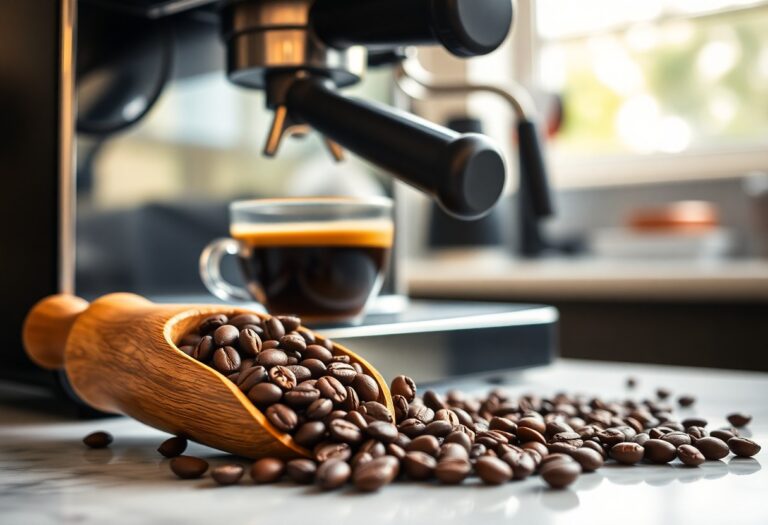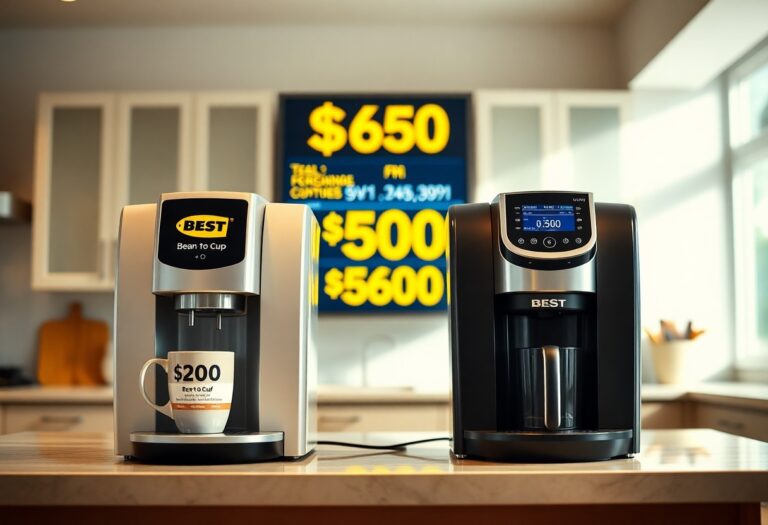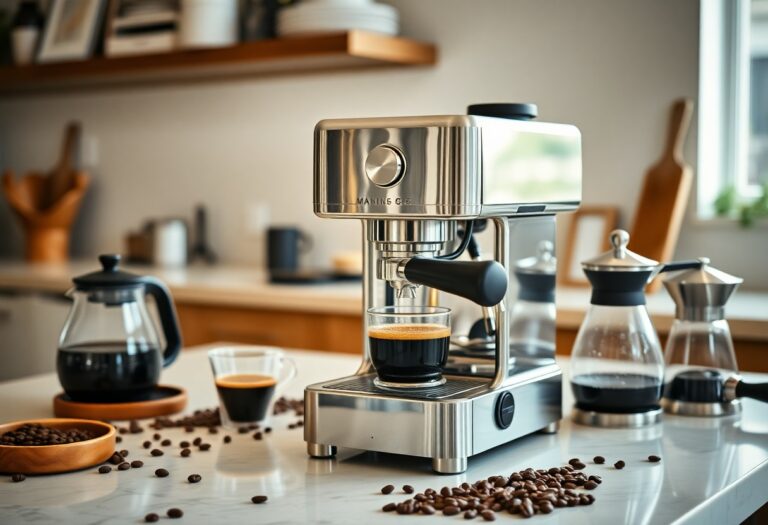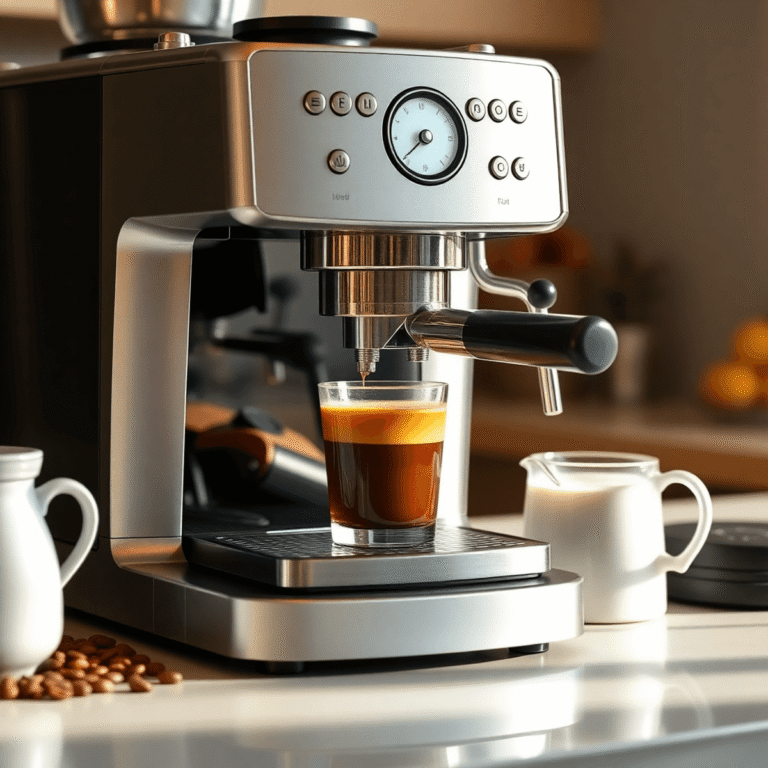What Coffee to Use in a Coffee Machine – Universal Guide
Guide your coffee experience with the right choice of beans to enhance your brewing process. The type of coffee you use in your machine can significantly affect the flavor, aroma, and overall quality of your cup. Selecting fresh, high-quality coffee beans is imperative, as stale or poor-quality coffee can create a lackluster brew. This guide will help you explore the various options available and lead you towards how to choose the best coffee for your coffee machine. Your perfect cup is just the right choice away!
Key Takeaways:
- Opt for coffee beans that are specifically labeled for brewing methods compatible with your coffee machine.
- Freshness is vital; use coffee that has been recently roasted and stored properly to enhance flavor.
- Pay attention to the grind size; it should match your coffee machine type for optimal extraction.
- Experiment with different coffee origins and blends to find personal flavor preferences.
- Consider using filtered water in your machine to improve the overall taste of your coffee.
Crafting the Perfect Brew: Coffee Varieties Explained
Understanding your coffee options helps you craft the perfect brew tailored to your taste. Each coffee variety possesses distinct characteristics influenced by factors such as geography, climate, and processing methods. From lively, fruity notes to deep, chocolatey flavors, knowing these nuances allows you to select a blend that complements your preferred brewing method, whether it’s a rich espresso or a smooth drip coffee. By experimenting with various beans, you can unlock a world of flavors and find what truly enhances your coffee experience.
Arabica vs. Robusta: The Battle of Beans
Arabica and Robusta are the two primary coffee bean varieties dominating the market. Arabica beans, known for their smoother and sweeter profile, typically possess a higher acidity, making them ideal for specialty coffee. In contrast, Robusta beans deliver a bolder, earthier flavor and contain more caffeine, offering a hearty kick. Your choice between these two can significantly impact your brew’s taste and effects, so understanding their characteristics is vital for making an informed decision.
The Impact of Single-Origin vs. Blends
Single-origin coffees boast unique flavors derived from specific regions or farms, allowing you to experience the distinctive profiles shaped by local conditions. Conversely, blends combine beans from various origins, aiming for a balanced flavor profile and consistency. While single-origin offers a unique tasting adventure, blends often cater to broader preferences. Choosing between these options can shape your daily coffee ritual, influencing flavor, aroma, and even how you perceive your brew’s body.
When selecting between single-origin and blends, consider your palate and what flavors resonate with you. Single-origin coffees provide an opportunity to explore specific flavor notes, such as the bright citrus of Ethiopian beans or the rich chocolate undertones of Colombian beans. These distinct profiles allow for a deeper appreciation of coffee terroir. Blends, however, can deliver a comforting familiarity, skillfully crafted to ensure that every cup tastes consistent. Ultimately, your decision depends on whether you seek adventure in your daily cup or prefer the reliability of a blended flavor experience.
Beyond the Bean: Understanding Roast Profiles
A coffee’s roast profile significantly impacts its flavor, aroma, and overall experience. Roasting transforms green beans, unlocking various compounds that contribute to a coffee’s distinct taste. By recognizing the different roast profiles—light, medium, and dark—you can better select the beans that align with your preferences and brewing method. Understanding these nuances not only enhances your coffee education but allows you to create a personalized coffee ritual that is even more enjoyable.
Light, Medium, and Dark Roasts: Flavor Implications
Light roasts maintain the original flavors of the coffee bean, offering bright acidity and floral or fruity notes. Medium roasts find a balance between acidity and sweetness, featuring caramel and nutty flavors. Dark roasts are characterized by deep, robust flavors often with hints of chocolate and smokiness, while the oils on the surface lead to a richer mouthfeel. Each roast level delivers a unique profile, catering to various taste preferences.
Freshness Matters: The Role of Roast Date
The roast date plays a significant role in achieving the best flavor from your coffee. Freshly roasted beans tend to have more vibrant and complex flavors, whereas older beans can lose their vital oils and freshness, leading to a duller cup. Ideally, you should consume coffee within two to four weeks of the roast date for optimal taste.
Beans start to lose their flavor the moment they’re roasted, as they begin to release gases and lose freshness. This is why coffee bags usually feature a roast date; it helps you determine when to purchase for the best experience. Try to buy your coffee from roasters that provide this date, and prioritize those that offer products within a week or two of roasting. Not only will you enjoy a better tasting brew, but you’ll also deepen your appreciation for the craftsmanship behind your favorite beans.

Grinding Right: Tailoring Your Grind for Optimal Extraction
Achieving the right grind for your coffee beans significantly influences the extraction process and ultimately, the taste of your brew. Different coffee machines require specific grind sizes to optimize flavor. For unparalleled results, consider matching your grind to your chosen brewing method, whether it’s an espresso machine, drip coffee maker, or French press. A consistent grind enhances extraction, leading to a rich and flavorful cup that captures the essence of your coffee bean selection.
Grind Size and Brew Methods: What You Need to Know
Your choice of grind size should align with your brewing method. For instance, espresso demands a fine grind to facilitate quick extraction, whereas coarser grinds suit brewing methods like French press that rely on longer steeping times. An inappropriate grind can lead to under-extraction, resulting in a sour taste, or over-extraction, creating bitterness. Tailoring your grind ensures you extract the optimal flavor compounds and aroma from your chosen coffee variety.
Grinding Tools: Choosing Between Burr and Blade
The type of grinder you use plays a pivotal role in the quality of your coffee. Burr grinders create a uniform particle size and can be adjusted for precise control over the grind, making them ideal for capturing the intricate flavors of specialty beans. In contrast, blade grinders can produce inconsistent grind sizes that might adversely affect the extraction process. While burr grinders offer superior consistency and flavor, high-quality blade grinders can serve well in a pinch.
Burr grinders come in two varieties: flat and conical. Flat burrs utilize two parallel plates that slice the beans consistently, while conical burrs feature a cone-shaped design that also offers even grinding but is less messy. Despite the higher upfront investment, burr grinders generally last longer and provide a superior grind, making them a smart choice for coffee enthusiasts. Blade grinders, while budget-friendly, can lead to uneven coffee ground, resulting in an imbalanced brew. For optimal extraction, investing in a quality burr grinder can elevate your coffee experience significantly.
Water Quality and Brewing Temperature: The Chemistry of Coffee
Water quality and brewing temperature play an crucial role in achieving the perfect cup of coffee. The interaction between water’s mineral content and the temperature at which you brew can either enhance or diminish the flavors of your carefully selected beans. Understanding these aspects helps you master the science behind brewing, leading to optimal extraction and a more enjoyable coffee experience.
| Factor | Effect on Flavor |
| Water Mineral Content | Enhances extraction and flavor notes |
| Brewing Temperature | Affects solubility and extraction rate |
The Essential Role of Water: Mineral Content and Flavor
The minerals in water profoundly impact your coffee’s flavor profile. Hard water, rich in calcium and magnesium, tends to accentuate sweetness and body. Conversely, soft water may lead to acidity and a lack of depth in flavor. Tailoring your water to have a balanced mineral content ensures you extract the best characteristics from your chosen coffee beans, unlocking hidden flavors and aromas.
| Water Type | Effect on Coffee |
| Hard Water | Enhances sweetness and body |
| Soft Water | May lead to acidity and flatness |
Brewing Temperatures: Finding the Goldilocks Zone
Brewing temperatures should ideally hover between 195°F to 205°F for optimal extraction. If your coffee is brewed at too low a temperature, you risk under-extraction, resulting in a weak and sour taste. On the other hand, excessively high temperatures can lead to over-extraction, making your cup bitter and harsh. Striking this balance ensures that you harness the full range of flavors from your coffee grounds.
| Temperature (°F) | Extraction Quality |
| Below 195°F | Under-extracted, sour flavor |
| 195°F – 205°F | Ideal extraction, balanced flavor |
| Above 205°F | Over-extracted, bitter taste |
Exploring the nuances of brewing temperatures can truly elevate your coffee-making routine. Using a thermometer can help you monitor the precise temperature of your water, ensuring that it stays within the optimal range. If your machine struggles to maintain consistent heat, consider investing in a quality coffee maker known for temperature stability. Small adjustments make a significant impact, and experimentation with temperature will lead you to craft your perfect cup every time.
| Method | Benefit |
| Thermometer | Ensures precise brewing temperature |
| Quality Coffee Maker | Maintains consistent heat during brewing |

Troubleshooting Your Brew: Common Pitfalls and Solutions
Even with the best coffee beans and equipment, your brew can sometimes fall short of expectations. Identifying and addressing common issues is necessary for crafting that ideal cup of coffee. Whether you’re facing sour notes or bitter undertones, knowing how to troubleshoot will elevate your coffee game. Pinpoint specific problems based on your brewing method, water temperature, and coffee grind to make the necessary adjustments for a delicious result.
Over-Extraction vs. Under-Extraction: Identifying Issues
Over-extraction typically results in a bitter cup, while under-extraction often leads to sour flavors. If your coffee tastes unpleasant, examine your brewing time and water temperature. For instance, using water that’s too hot or brewing for too long can negatively affect extraction. Conversely, too little time or lower temperatures might not extract enough flavor compounds, leaving you with a weak and acidic brew.
Adjusting Variables: How to Tweak for Perfect Flavor
To perfect your brew, adjusting variables like grind size, brewing time, and water temperature is necessary. If your coffee lacks depth, consider grinding your beans finer or increasing the brew time. On the flip side, coarser grounds or reducing the time can help avoid bitterness. Experimenting with water temperature is also key; a range of 195°F to 205°F balances extraction to unlock the best flavors of your coffee.
Making these adjustments involves trial and error. For example, changing your grind size may require altering the brewing time, as finer grinds extract more quickly than coarser ones. If you enjoy a floral note in your coffee but find it muted, try increasing the water temperature slightly or steeping for a few extra seconds. Keep notes on each tweak, so you can replicate your successes and avoid past mistakes, ensuring each cup is closer to perfection.
Conclusion
Summing up, selecting the right coffee for your coffee machine is crucial for achieving the perfect brew. You should consider factors like grind size, coffee type, and freshness to elevate your coffee experience. Whether you prefer robust dark roasts or light and fruity blends, aligning your choice with your brewing method will enhance the flavor profile. By embracing these guidelines, you can enjoy a consistently satisfying cup of coffee tailored to your taste preferences.
FAQ
Q: What types of coffee beans are best for coffee machines?
A: The best types of coffee beans for coffee machines are typically Arabica and Robusta. Arabica beans are known for their smooth, complex flavors, while Robusta beans provide a stronger, more bitter taste and higher caffeine content. For most home coffee machines, a medium roast Arabica bean is often recommended for its well-rounded flavor, but experimenting with blends can lead you to your preferred taste.
Q: Should I use pre-ground coffee or whole beans in my coffee machine?
A: While both options can produce a good cup of coffee, whole beans generally offer fresher flavor and aroma. Grinding your own beans just before brewing ensures maximum freshness and allows you to control the grind size, which is important for extraction. If convenience is a priority, pre-ground coffee can be used, but look for quality brands that package their coffee properly to maintain freshness.
Q: What grind size is ideal for coffee machines?
A: The ideal grind size varies depending on the type of coffee machine you are using. For example, a coarse grind is best for French presses, while a medium grind works well for drip coffee makers. Espresso machines require a fine grind for optimal extraction. It’s necessary to match the grind size with your coffee machine type to achieve the best flavor and extraction efficiency.
Q: Can I use flavored coffee beans in my coffee machine?
A: Yes, flavored coffee beans can be used in most coffee machines. Keep in mind that flavored coffees often have added oils that can affect the machine over time, so be sure to clean your machine regularly. If you enjoy the taste of flavored coffee, look for high-quality beans and ensure you’re using them in moderation to maintain the lifespan of your coffee machine.
Q: What factors should I consider when choosing coffee for a coffee machine?
A: When identifying coffee for your coffee machine, consider factors such as roast type, bean origin, and grind size. Additionally, consider your personal taste preferences—some might enjoy brighter, fruitier flavors, while others may prefer rich, darker roasts. Freshness is also important; always check the roast date before purchasing to ensure you’re buying the freshest product possible. Lastly, think about brewing time and temperature, as these can also affect the flavor of your coffee.







